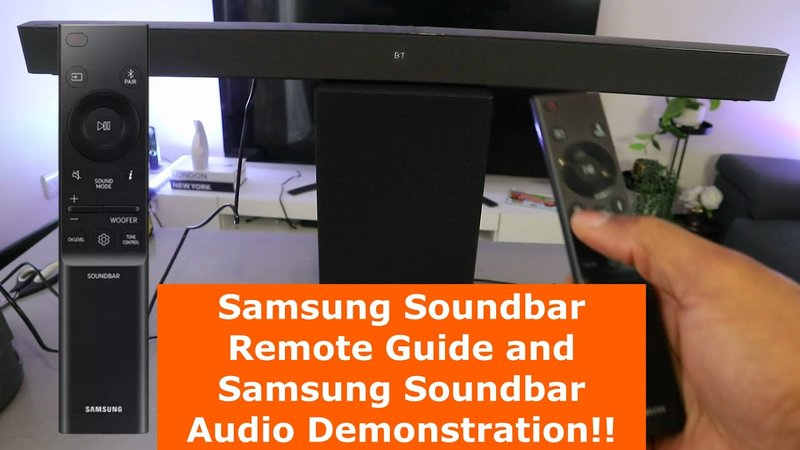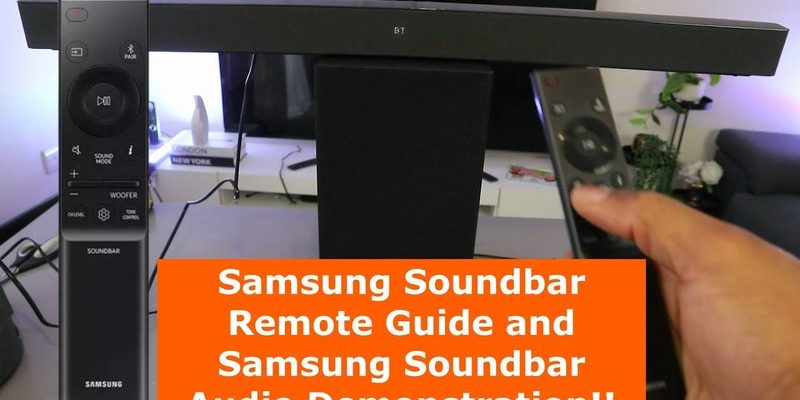
Here’s the thing: a lot of folks want to control their soundbar and projector with as little hassle as possible. If you’ve got a Samsung soundbar remote, you’ve probably wondered: “Can I use this nifty gadget with my projector, too? Or am I doomed to remote overload forever?” Well, you’re in the right place. Let me walk you through how this works (and doesn’t work), what you need, and some little tricks that might just save your sanity the next time you cue up Netflix or play a YouTube concert.
How Samsung Soundbar Remotes Work (And What Makes Them Special)
Most Samsung soundbar remotes are built to keep things simple. They’re slim, pocket-friendly, and—unlike some remotes—don’t require a PhD to use. Basically, these remotes send out an IR (infrared) signal, which is like an invisible beam of light that “talks” to your soundbar and tells it what to do. Some newer versions might also support Bluetooth for pairing, but IR remains the go-to.
If you’re thinking, “Well, can’t I just point my Samsung remote at my projector and expect it to work?” I get it, but sadly, it’s not usually that simple. Projectors and soundbars just don’t speak the same IR language by default. Your soundbar remote is coded to control only Samsung soundbars, and most projectors won’t recognize those commands. It’s like trying to use your car key on your neighbor’s car—nice idea, but you’ll just set off the alarm.
There is a silver lining, though. Some Samsung remotes do have basic universal functionality, and more advanced setups can “teach” remotes how to talk to other devices, projectors included. Getting these devices to play nice together often comes down to compatibility, codes, and a little bit of creativity with syncing or pairing.
Connecting Your Samsung Soundbar to a Projector: The Basics
Here’s the million-dollar question: how do you actually get your soundbar and projector to work together? First, let’s clarify: your Samsung soundbar remote is designed for audio controls (volume, power, sound modes), while your projector remote handles the visuals (power, input, focus). But, if you want one remote to rule them all (or at least avoid juggling), you need to think about what connects what.
Most projectors don’t output audio by themselves—they just spit out the video. You’ll typically connect your streaming stick, Blu-ray player, or gaming console directly to the projector, then send the audio output to your soundbar. This might be through HDMI ARC (Audio Return Channel), optical cable, or even Bluetooth if your devices support it.
Let me explain with a quick setup example:
- Plug your streaming device (like a Roku or Fire Stick) into the projector’s HDMI input.
- Connect the projector’s audio output to your Samsung soundbar. This could be an optical cable, HDMI ARC, or Bluetooth (if supported on both ends).
- Use your projector remote to control the video source, and your Samsung soundbar remote for audio tweaks.
Sounds a bit old-school, but this actually covers most setups I’ve seen. If your devices support HDMI-CEC, you might even control multiple devices with a single remote. (More on that in a sec.) But don’t toss out your soundbar remote just yet—it has its own superpowers.
Pairing, Syncing, and Using Codes: Making Remotes Play Nice
You might be wondering, “Is there a way to pair or sync my Samsung soundbar remote directly with my projector?” The answer depends on the models and technology at play. Most Samsung soundbar remotes use proprietary codes, so they’re not universal out of the box. But some newer Samsung remotes, especially those labeled “universal,” can be programmed using device codes.
If your remote supports universal pairing, you’ll find a booklet or online database with codes for various brands—including, sometimes, common projector brands. The pairing process usually looks like this:
- Press and hold a specific button on your Samsung remote (often “Set” or “Pair”).
- Enter the code for your projector’s brand when prompted.
- Test basic functions—like power or volume—to see if the code worked.
If you get lucky, you’ll now have a single remote that handles both your soundbar and your projector’s basic features. But, if your soundbar remote isn’t universal, you’ll be stuck with two (or more) remotes unless you explore alternatives like third-party universal remotes or smartphone apps.
Pro tip: Universal remotes (like Logitech Harmony) can often replace both your projector and soundbar remotes. You just enter each device’s code, and suddenly, you’re the master of your media universe.
Why HDMI-CEC Is a Game-Changer (If Your Devices Support It)
Let’s talk about HDMI-CEC—short for Consumer Electronics Control. It’s basically a magic protocol hidden inside HDMI cables that lets different devices “talk” to each other, like a nerdy version of telepathy. If your projector and Samsung soundbar both support HDMI-CEC, you can control multiple devices with a single remote, usually whichever remote you pick up first.
Here’s how it might look:
- You press “Power” on your projector remote.
- Through HDMI-CEC, this signal passes to your soundbar, telling it to wake up too.
- Adjusting volume on your projector remote also controls the soundbar—no need to reach for another remote.
Not every projector or soundbar supports HDMI-CEC, and (let’s be real) sometimes it needs to be manually enabled in the settings. Look for terms like “Anynet+” (Samsung’s CEC branding), “CEC,” or “Control HDMI” in your device’s setup menus.
One little catch: HDMI-CEC can sometimes act finicky. Maybe your devices don’t “see” each other right away, or a firmware update breaks the connection. If you run into issues, try:
- Turning everything off, unplugging the HDMI cables, waiting a minute, then plugging them back in.
- Making sure CEC is enabled on all devices.
- Using high-quality HDMI cables.
Trust me, sometimes the old “turn it off and on again” move works wonders.
Dealing With Common Remote Problems and Troubleshooting
Let’s be honest, remotes love to mess with us at the worst possible moment. Maybe your Samsung soundbar remote suddenly stops working, or it won’t sync with the projector no matter what you try. Here’s what I’ve learned from my own battles with tech gremlins:
First—check the batteries. I know it sounds silly, but honestly, dead or weak batteries are the culprit behind half of all remote problems. Fresh batteries can work magic.
If that doesn’t do the trick, try resetting your Samsung remote. Usually, it involves holding a combo of buttons (check your soundbar manual or Google your exact model). Sometimes, just resetting the remote will get it back on speaking terms with your soundbar—or at least stop it from going rogue.
Still having trouble with pairing or syncing? Make sure your projector isn’t blocking the IR sensor line (sometimes a tiny piece of furniture is all it takes to interfere). If you’re trying to use codes, double-check you’re using the right one for your projector brand. And if all else fails, consider using your devices’ built-in troubleshooting modes—most have on-screen guides to help you diagnose connection issues.
Quick insight: When in doubt, using a universal remote app on your phone is a clever alternative. Some apps can even learn the IR signals of your existing remotes, so you can banish remote clutter entirely.
Comparing Samsung Remotes and Universal Remotes: Which Is Better for Projectors?
If you’re weighing your options, let me break it down. Samsung’s soundbar remotes are sleek and reliable for audio, but they’re not designed to control projectors—at least not out of the box. Universal remotes, though, are made for this very situation. They can sync, set codes, reset themselves, and even control your smart lights if you want to get fancy.
But there’s something to be said for simplicity. If you just want to control your soundbar and nothing else, the original Samsung remote is perfect: fewer buttons, less confusion, and you never have to wonder what “AUX 2” means. Universal remotes, on the other hand, can save you from remote overload if you’re juggling a projector, soundbar, Blu-ray, and more. Just be ready to spend a bit of time on setup.
Some people even use both: keep the Samsung remote handy for advanced sound modes, and use a universal remote or CEC controls for basic everyday use. It’s all about what feels easiest in your living room.
Maintaining Your Remotes: Batteries, Care, and When to Replace
It’s honestly amazing how far a little remote TLC can go. Regularly swapping out the batteries (once a year is a good rule of thumb), keeping your remotes away from sticky hands or spilled soda, and storing them somewhere obvious all help keep things running smoothly.
If your Samsung soundbar remote stops working even with new batteries, it might just be time for a replacement. They’re pretty easy to order online. But before you toss it, try resetting or cleaning the battery contacts with a lint-free cloth. If you’re feeling bold, some people will even gently open the remote and clean the inside (just go slow and don’t lose any tiny springs).
For universal remotes, you’ll occasionally need to reset or reprogram them, especially if you buy a new projector or upgrade your soundbar. Keep the manuals or save the codes in your phone’s notes app for easy reference. It may seem a bit fussy, but trust me, it saves headaches down the line.
Projector and Soundbar Remote Alternatives: Apps and Voice Control
Maybe you’re ready to ditch remotes entirely—yes, that is possible. Many projectors and soundbars now support smartphone apps for full control. Samsung has its SmartThings app, which can connect to newer soundbars and some smart home projectors. With these, your phone basically becomes a super-remote: you can adjust volume, switch inputs, and even update firmware without ever digging through the couch cushions.
Voice assistants are also making a splash. If your living room is decked out with Alexa, Google Assistant, or Bixby, you can tell your smart speaker to “turn up the soundbar” or “switch projector input” hands-free. It’s a little bit like living in the future (and occasionally, your smart speaker will answer questions you didn’t even ask, but hey, progress).
So if your Samsung soundbar remote isn’t cutting it, or you’re just tired of remote wars, consider making your phone or voice the new boss of home theater night.
Wrapping Up: Finding Your Perfect Remote Setup
It’s funny how something as simple as a remote can totally change the movie-night mood. One remote too many, and suddenly you’re playing “guess the button” instead of relaxing. The good news is, with a bit of know-how, you can tailor your setup so it works exactly how you want—whether that means sticking with your trusty Samsung soundbar remote, leveling up to a universal remote, or making your phone the command center.
Projectors and soundbars are all about making your home theater experience amazing. Don’t let a handful of remotes get in the way. Try out the tips here, experiment with codes, give HDMI-CEC a shot, or try an app. You’ll land on a setup that feels just right—and maybe, just maybe, your coffee table will be clutter-free for once.
